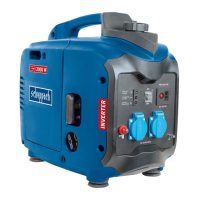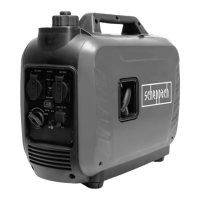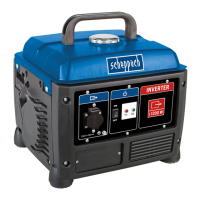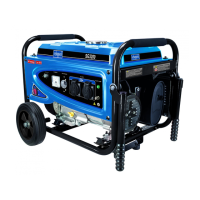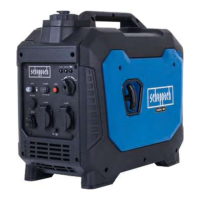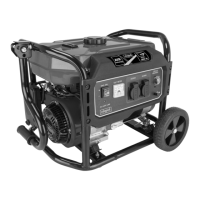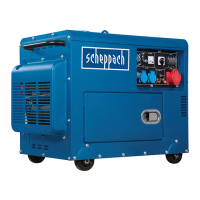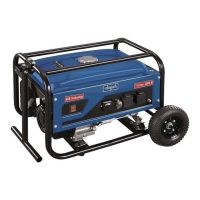57
The manufacturer is not responsible for the resulting
damages; the user solely bears the risk. Only use the
recommended spark plugs or identical spark plugs.
Clean the air lter, g. 10
1 Release the 2 clamps (E) top and bottom on the
lter cover (F)
2 Remove the lter cover (F)
3 Clean the foam pre-lter in a non-ammable solvent.
Attention: Do not use petrol or cleaning solvents
with a low ash point to clean the air lter element.
This could result in re or explosion.
4 Squeeze the pre-lter in order to remove the solvent/
soapy water.
5 Clean the paper lter by tapping it.
6 Rinse the washed lter element with clean water.
7 Allow the lter element to dry or blow it dry with com-
pressed air.
8 Hang the lter cover in place once more and secure
with the 2 clamps
If the engine is operated in very dusty environments,
clean the air lter daily or after every ten operating hours.
Never run the engine without an air lter or with a dam-
aged air lter. This would allow dirt into the engine, which
would result in severe damage to the engine.
The manufacturer is not responsible for the resulting
damages; the user solely bears the risk.
Transport and storage
1 Allow the engine to cool before transporting or stor-
ing it.
2 Before transporting the power unit, switch the igni-
tion to the (off) position and turn the fuel valve to the
(off) position
3 Keep the power unit level so that no petrol is spilled.
Petrol vapour or spilled petrol may ignite.
4 Ensure that the power unit does not fall and do not
subject it to any blows during transport.
5 Do not place any heavy items on the power unit.
Before storing the unit for a long period of time: En-
sure that the storage location is not excessively damp
or dusty.
Una candela di accensione lenta può danneggiare il mo-
tore in caso di surriscaldamento.
Stringendo troppo forte si può danneggiare la lettatura
nella testa del cilindro.
Il produttore non si assume alcuna responsabilita
per i danni risultanti da tale uso. Il rischio e esclu-
sivamente a carico dell‘utilizzatore. Utilizzare solo
candele di accensione raccomandate o simili.
Pulire il ltro dell‘aria Fig. 10
1 Allentare i 2 morsetti (E) superiore e inferiore sulla
copertura del ltro (F)
2 Rimuovere la copertura del ltro (F)
3 Pulire il preltro di schiuma in un solvente non in-
ammabile.
Attenzione: non utilizzare benzina o soluzioni deter-
genti con un basso grado di inammabilità per pulire
la cartuccia del ltro dell’aria. Ciò potrebbe causare
incendi o esplosione.
4. Spingere in fuori il preltro per rimuovere il solvente/
liscivia di sapone.
5. Pulire il ltro di carta sbattendolo.
6. Sciacquare a fondo l‘elemento ltro lavato con acqua
pulita
7. Far asciugare a fondo l‘elemento ltro oppure asciu-
garlo con aria compressa.
8. Riattaccare la copertura del ltro e ssare coi 2 mor-
setti.
Se il motore viene fatto funzionare in un ambiente molto
polveroso, pulire quotidianamente il ltro dell‘aria ogni
giorno oppure ogni dieci ore di esercizio.
Non far girare il motore senza la cartuccia del ltro
dell’aria o nel caso in cui questa sia danneggiata. Se
la sporcizia penetra nel motore possono prodursi gravi
danni al motore.
Il produttore non si assume alcuna responsabilità per i
danni risultanti da tale uso. Il rischio è esclusivamente
a carico dell‘utilizzatore.
Trasporto e stoccaggio
1. Lasciare che il motore si raffreddi prima di traspor-
tarlo o immagazzinarlo.
2. Prima del trasporto del gruppo elettrogeno, portare
l‘interruttore di accensione in posizione (off) e il ru-
binetto di benzina in posizione (off).
3. Tenere il gruppo elettrogeno in posizione orizzontale
in modo che la benzina non fuoriesca. Vapori di ben-
zina o benzina versata possono incendiarsi.
4. Non lasciare che il gruppo elettrogeno cada e non
esporlo a colpi durante il trasporto.
5. Non appoggiare oggetti pesanti sul gruppo elettro-
geno.
Prima dell‘immagazzinamento dell‘apparecchio per un
lungo periodo di tempo: accertarsi che il luogo di depo-
sito non sia eccessivamente umido o polveroso.
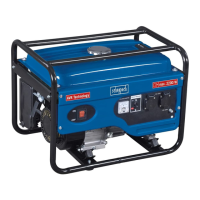
